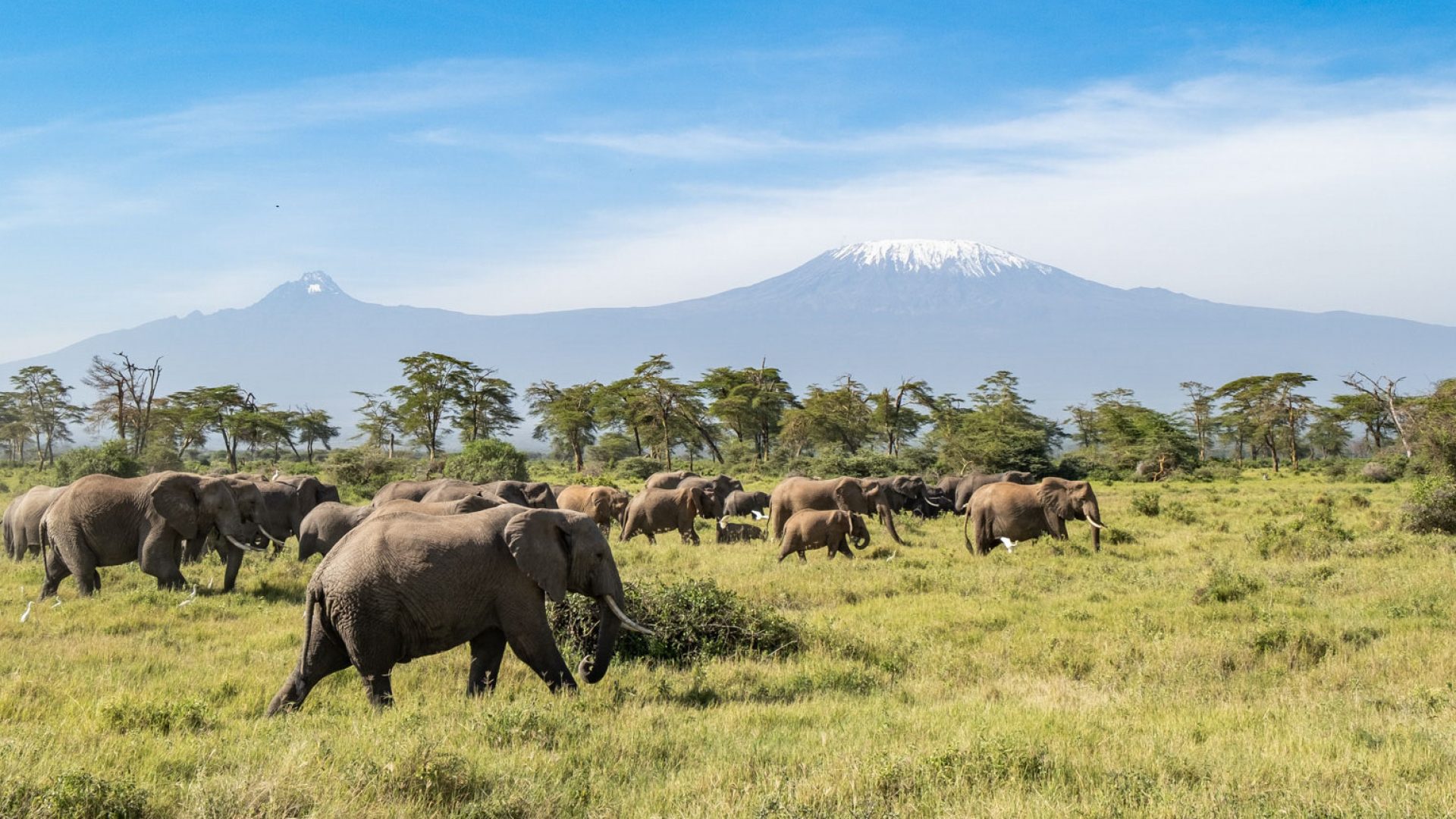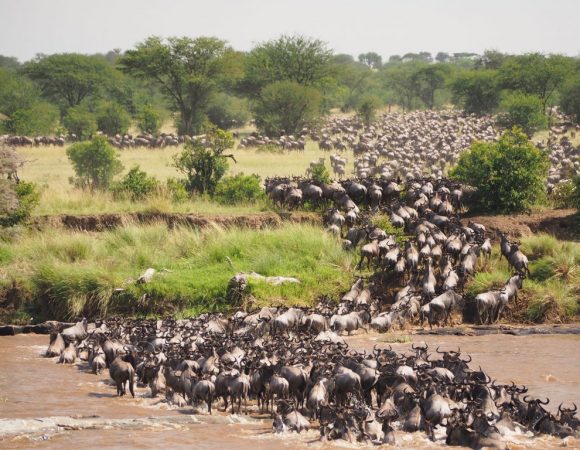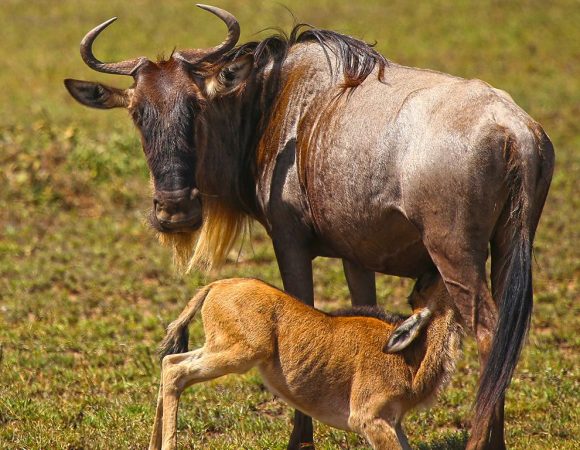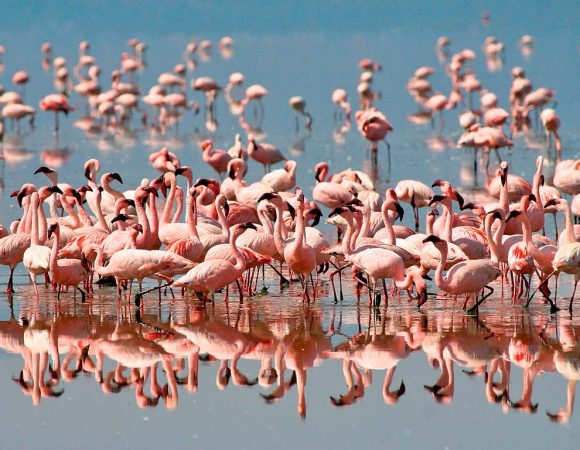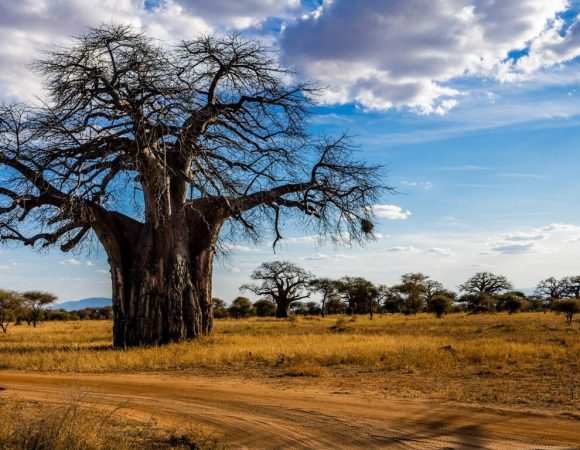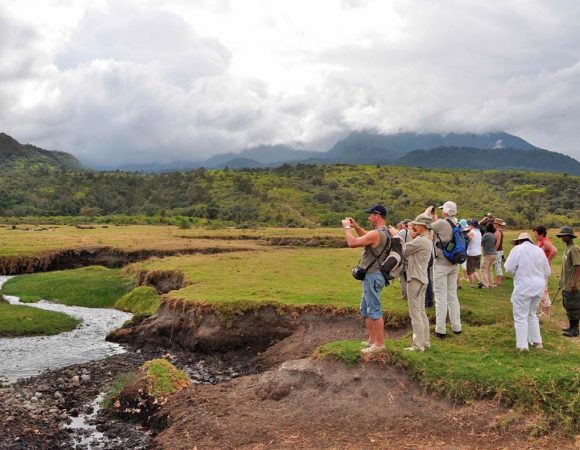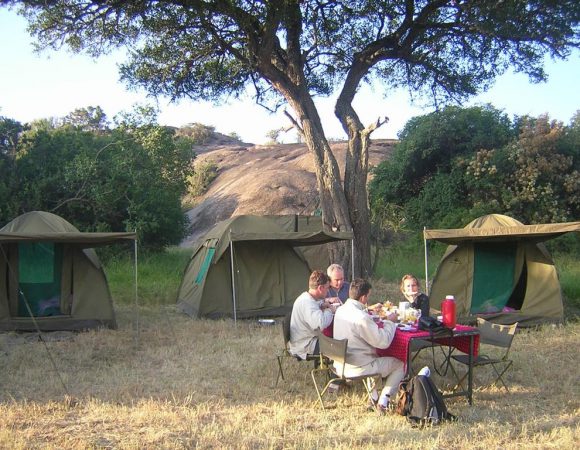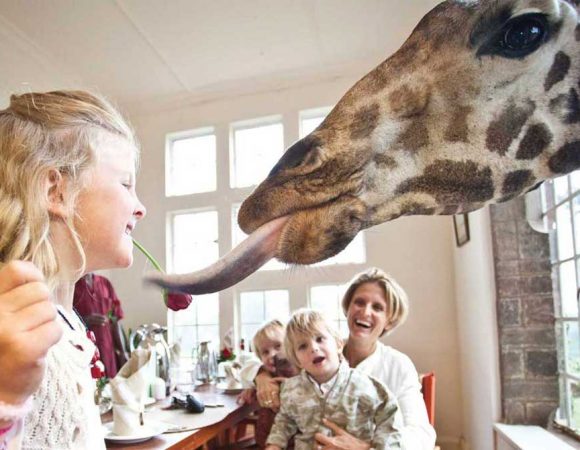- Home
- Amboseli National Park
Amboseli National Park
Amboseli National Park is the best place in Africa with the best view of Mount Kilimanjaro. it gives you that surreal view of the dry savannah that the Mount Kilimanjaro overlooks down on an oasis taking centre stage with emerald-green, and seasonal swamps, to see elephants in dense concentrations.
How to get to Amboseli National Park
Although first impressions when you arrive at the airstrip can be of a bleak dust bowl, any doubts about the park are allayed by its magnificent elephant herds and high counts of other plains animals which converge to graze and drink at the park’s permanent swamps and lakes. The wildlife can often be viewed against the strikingly beautiful backdrop of Kilimanjaro, towering behind and offering scenes that are instantly recognisable. Although Amboseli has a wildebeest and zebra migration (like the Maasai Mara’s but on a very much smaller scale as they disperse across the ecosystem and into Tanzania), thousands of animals are resident here all year round.Amboseli National Park
Safaris in Amboseli National Park
With the main safari attraction in the Amboseli National Park being the dramatic views of the Mount Kilimanjaro and easy to-do walking safaris in the uncrowded wilderness of the Amboseli in the remote wilderness of Selenkay Conservancy in the northern side of this Kenyan park, wild game viewing easily carries the day in terms of activities, attractions and the dominant factor, Amboseli National Park safaris.
Click here to book a safari to the Amboseli National Park
Mount Kilimanjaro View at Amboseli
The best view of Mount Kilimanjaro, the tallest free-standing mountain in the world, peaking at 5995m above sea level and rising nearly 5000m can be seen here towering above the Amboseli plains. Being 30km from the Amboseli, the peaks of Kilimanjaro (Shira, Mawenzi and the highest, Kibo) can be clearly seen despite being partly of sometimes heavily covered by clouds. During the rainy season, at sunset and sunrise the sight can be strikingly beautiful due to the covering by the fresh snow caps.
Fauna and flora of Amboseli National Park
You cannot miss to notice the wetlands and marshy swamps of the Amboseli National Park which are Lake Kioko which dominates the western part of the Amboseli park, and the Longinye Swamp which attracts the most wildlife in the east of the park. Perhaps most notably is the Enkongo Narok swamp and its central feature. These permanent swamps draw water from the melting snowcaps of the Mount Kilimanjaro, which spreads into the ashy volcanic rock then rising to spread all over the plains all year round. the aftermath after the rains stop falling is a spectacle of marvellous carpets of pasture and as the dry spell endures eventually for the rest of the year, sedges, waterlilies and papyrus provide a brilliant contrast with the dry surrounding of the plains. The environment to the south of the Amboseli national park cuts out a woodland setting with yellow-barked acacia and other species of trees which provide diet for various inhabitants like Maasai giraffes and shades for hunting lions and cheetah.
The aforementioned reason supports amazing scenery of giraffes and elephants with the beautiful, towering Mount Kilimanjaro at the background, Amboseli’s swamp-loving elephants, slate-grey with heavy swamp clay, and sometimes wearing incongrous wreathes of plant matter, number around 1500 individuals in more than 40 herds, most of them led by matriarchs.
Although most of southern Kenya’s plains widlife can be seen at Amboseli – including Thomson’s and Grant’s gazelles, buffalo, hartebeest, eland and waterbuck – the most numerous animals of the open plains are wildebeest and Burchell’s zebra. Still to some extent migratory, mixed herds of both species move across the savannah with the seasons, between the Tanzanian plains west of Kilimanjaro and the Kajiado plains north of Amboseli. Following the scent of new grazing, and concentrating near the Amboseli swamps at the end of the dry seasons, they calve and foal early in the year, before the first of the long rains in March. Out in the drier areas, which are inhospitable to many species, you’ll see fringe-eared oryx and gerenuk.
With a few years of tolerance from the local communities, the Amboseli predators, with their relatively quick generational cycles, have made a rapid comeback, and our recent visits have revealed good sightings of lions and hyenas, although cheetah have proved more elusive.
Bird counts in Amboseli can be astonishing: there are reckoned to be as many as 400 species present in this small park, including native rarities like the Madagascar squacco heron and the Taveta golden weaver (relatively common at camps and lodges around the park) as well as Palearctic migrants such as the Caspian plover. The water birds are the highlights, and in many areas the park’s tracks follow close to the water’s edge, allowing you great sightings of specialities like the long-toed lapwing and rufous-bellied heron – if you can take your eyes of the elephants in the swamp.
Amboseli’s elephants
The elephants of Amboseli have been the focus of a long research project run by the Amboseli Trust for Elephants. Founded in 1975 by Cynthia Moss, who had met elephant researcher Iain Douglas-Hamilton in Tanzania a few years earlier, the trust has become one of the most important elephant research centres in the world. It was here that elephants’ infrasonic communications (‘tummy rumbles’) were first recorded and studied and where the true complexity of their social structures and inter-personal relationships, and the sophistication of their cogntive abilities, were revealed.
Landmarks and divisions of the Amboseli ecosystem
Although the dominant presence of Kilimanjaro marks the southern horizon and seems to fill half the sky, the Amboseli ecosystem, the region has a number of other important landmarks and features that provide orientation and variety to game drives. The obvious place to start is the small kopje known as Observation Hill, just to the west of Lake Kioko. Parking at the bottom you’re allowed to walk to the top, from where you can gaze across the whole park and can often see past the fringing reeds to the resident hippos in the lake.
Looking northwest, the flat, dusty plain is ‘Lake Amboseli’ – a very occasionally rain-filled zone that occupies the northwest corner of the park. Some 5km to the east, the human ‘reserve’ of Ol Tukai, in the centre of the park, is the fenced location of Amboseli’s park headquarters, the big Ol Tukai Lodge, and the currently mothballed Amboseli Lodge. If you’re in need of a comfort break, a cold drink or another leg stretch, drivers will often pause a game drive to take a break here.
The Amboseli region’s artificial divisions start with the Amboseli National Park itself. Bordering the park to the west is the Kitirua Game Conservancy, with the luxury Tortilis Camp. A fair way north of the park, commnly accessed by road transfer from Amboseli airstrip, lies the quite remote Selenkay Conservancy, location of Porini Amboseli Camp. On the southeast side of the park, closer to Kilimanjaro than anywhere else in the region, lies Elerai Conservancy and Satao Elerai Camp.
Selenkay Conservancy
North of Amboseli proper, the Selenkay Conservancy – a beautiful stretch of woodland, stream margin and open plains – offers promise where the total-exclusion model of the national parks sometimes seems to be stuck in conflict. Jake Grieves-Cook, a former game warden and head of the Kenya Tourist Board, visited this area as a young man in the 1970s when it was teeming with wildlife. Returning in the 1990s, he found the wildlife decimated, elephants absent and the environment degraded by livestock over-grazing. He met the Maasai elders and discussed setting up a wildlife conservancy on their land to create a protected habitat to bring back the wildlife and generate an income for the community. The Selenkay Conservancy was the result, and a wide variety of wildlife has now returned here, including good numbers of elephants that had not been seen for 20 years. You can visit Selenkay by staying at Porini Amboseli Camp.
Kitirua Conservancy
Between the south-west side of the national park and the Tanzanian borders lies the exclusive 120km² Kitirua Conservancy, location of Tortilis Camp, named after the flat-topped Acacia tortilis umbrella thorn tree, common to the area. From here, you have access both to Amboseli National Park’s famous elephant swamps and to the grazing and predator lands of Kitirua, which can only be visited by Tortilis guests.
Safaris in Chyulu Hills National Park
One of Kenya’s least-visited, least-developed national parks, the Chyulu Hills are a geologically recent lava ridge with plenty of game in the woodland savannah on the western, lower slopes, including eland, wildebeest, zebra, giraffe, elephant and buffalo. Deep in the lava fields there are also a few wild black rhinos, closedly guarded by rangers. On the western slopes, there are two superb places to stay, Ol Donyo Lodge, and Campi ya Kanzi.
The crest of the hills is another world, partly swathed in mossy cloud forest, where giant forest hogs barge through the undergrowth watched by goggle-eyed chameleons and spectacularly large, silvery-cheeked hornbills. Other highland forest birds that can be encountered here include the Abyssinian crimsonwing and a partly terrestrial pigeon – the lemon or cinnamon dove.
History of the Amboseli region
The earliest humans in the Amboseli region were hunter-gatherers, who had the plains, swamps and woodlands to themselves until the Bantu-speaking Chagga and Kamba peoples began to arrive from the highlands at some point around 1500 years ago. By the early 17th century, the first Maasai cattle herders had arrived in the region, having moved south from the flood plains of the upper Nile over the previous century.
The first European visitor in the Amboseli region was the Scottish explorer Joseph Thomson, who walked through in 1883. The remarkably sensitive travels of the young Thomson (he was aged just 25) covered a huge portion of southern Kenya as far west as Lake Victoria, with his 150-strong column. It was always claimed that nobody had ever lost their life on a Thomson safari, unlike the violent behaviour of so many of those who followed the trails he blazed. Although a German missionary, Johann Rebmann, had given an account of snow-capped Kilimanjaro in 1848, Thomson was the first person to provide a written record of what was then known as the Njiri Plain. On the northwest side he found Lake Amboseli entirely dry – its usual state even today – with mineral salts encrusting its surface and shimmering in the heat.
The Southern Maasai Reserve, a vast region stretching from Nairobi to Kilimanjaro and west to the Mara River, was created in 1899 in an attempt to confine the nomadic Maasai to a region that wasn’t of interest to colonial settlers intent on farming. In 1948, the colonial government established the Amboseli Reserve, this time focusing more on the wildlife, but acknowledging the rights of Maasai pastoralists to graze and water their herds in this important wetland. The region came under Maasai control through Kajiado District Council in 1961, but encroachment, booming population and a rise in tourism prompted President Jomo Kenyatta to withdraw local control and put the area in the hands of the National Parks service in 1974. As a result, Amboseli National Park became a total exclusion zone for the Maasai community, who were evicted and prevented from using the swamps to water their cattle. Ironically, far from protecting the wildlife, the relatively small new national park (just 400km²) so enraged the local community that first the area’s magnificent, long-horned black rhinos and then most of its lions were wiped out as the excluded herders retaliated with spears.
Amboseli has been a high-profile bellwether for human-wildlife relations in Kenya ever since, although the balance is much healthier these days as local communities increasingly recognise the value of the wildlife ‘resource’ in attracting tourists and bringing them an income. This is particularly important where the Maasai are involved directly through leasing their own land as community conservancies around the fringes of the national park to safari operators and taking jobs at safari camps. The Kenyan safari part takes you to Lake Nakuru, Amboseli and Masai Mara Game Reserve whereby the Tanzania safari package visits the Tarangire National Park, the Ngorongoro Crater and the Ndutu migration area in Southern Serengeti.”


